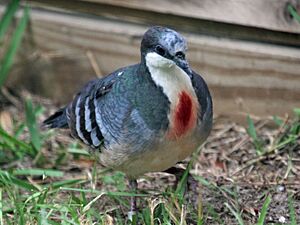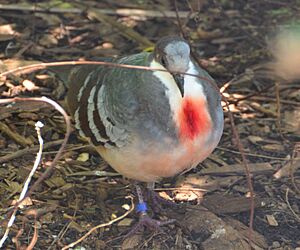Luzon bleeding-heart facts for kids
Quick facts for kids Luzon bleeding-heart |
|
|---|---|
 |
|
| Conservation status | |
| Scientific classification | |
| Genus: |
Gallicolumba
|
| Species: |
luzonica
|
The Luzon bleeding-heart is a special type of ground dove. People also call it the bleeding-heart dove, bleeding-heart pigeon, or punay. Its scientific name is Gallicolumba luzonica.
This bird gets its name from a bright red-orange patch on its chest. It looks like blood is running down its feathers! This "blood" patch is most noticeable on the Luzon bleeding-heart compared to other similar doves. The native name for this bird in the Tagalog is punay. It is also sometimes called paloma de punalada, which means 'stabbed pigeon'.
What Does the Luzon Bleeding-Heart Look Like?
The top part of the Luzon bleeding-heart is a dark grey color. But this bird's feathers are iridescent. This means they can shimmer and change color in different light. You might see purple, royal blue, or even a bottle-green color!
Their wings have black stripes. The feathers on their belly and under their wings are a light brown or reddish-brown color.
It can be a bit tricky to tell male and female Luzon bleeding-hearts apart. This is called sexual dimorphism, meaning there are only small differences between the sexes. Males are usually a bit bigger. Their red chest patch is also brighter and stands out more. Females have a slightly duller red patch. Like most doves, they have a round body, a short tail, and long legs.
Where Do Luzon Bleeding-Hearts Live?
The Luzon bleeding-heart lives only on the island of Luzon in the Philippines. When an animal or plant lives only in one specific place, it is called endemic. Locals on Luzon call this bird Puñalada.
These doves live in forests, both old and new. You can find them in areas up to 1,400 meters (about 4,600 feet) above sea level. They mostly stay on the ground, where they eat seeds, berries, and grubs. They are very shy and quiet birds. They rarely fly up into trees, except when they are building a nest. Unlike other bleeding-heart doves, they usually lay two eggs at a time.
There are three different types, or subspecies, of the Luzon bleeding-heart:
- Gallicolumba luzonica luzonica
- Gallicolumba luzonica griseolateralis
- Gallicolumba luzonica rubiventris
The Gallicolumba luzonica luzonica lives in the central and southern parts of Luzon island. It also lives on the nearby Polillo Islands. The Gallicolumba luzonica griseolateralis lives in the northern part of Luzon. The Gallicolumba luzonica rubiventris is found only on Catanduanes Island. Only one of these birds was ever found there in 1971. This type is very rare and might even be extinct now.
Why Is the Luzon Bleeding-Heart in Danger?
As of 2016, the Luzon bleeding-heart is listed as "Near Threatened" by the IUCN (International Union for Conservation of Nature). This means it could become endangered soon if we don't protect it.
The biggest threats to these birds are:
- Habitat Loss: Their forest homes are being cut down. People clear land for timber (wood) and for farms. This breaks up their living areas into smaller pieces.
- Trapping: People also catch these birds to keep as pets. Their beautiful, striking feathers make them popular, but this harms their wild populations.
Protecting their forest homes and stopping illegal trapping are important steps to help the Luzon bleeding-heart survive.




